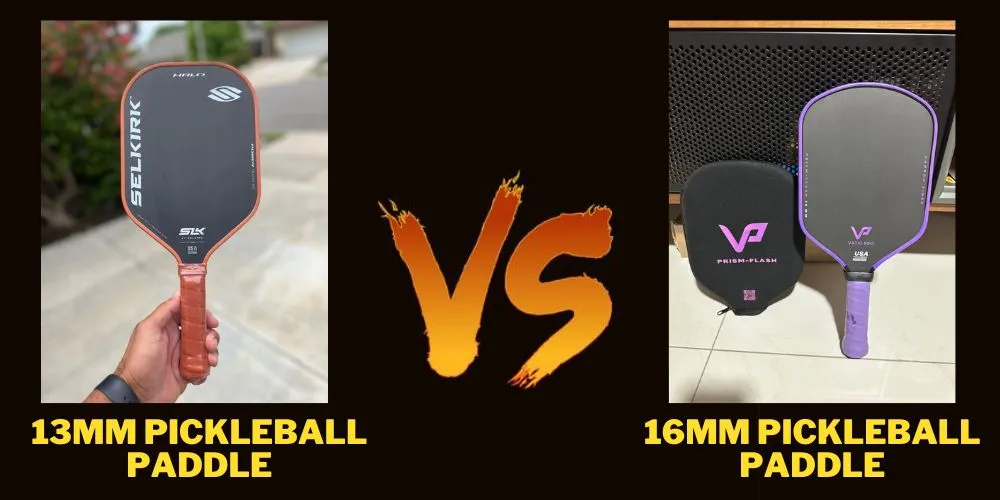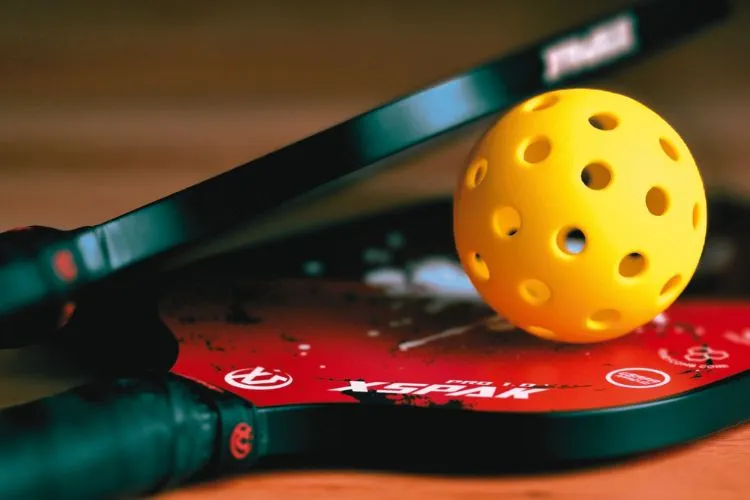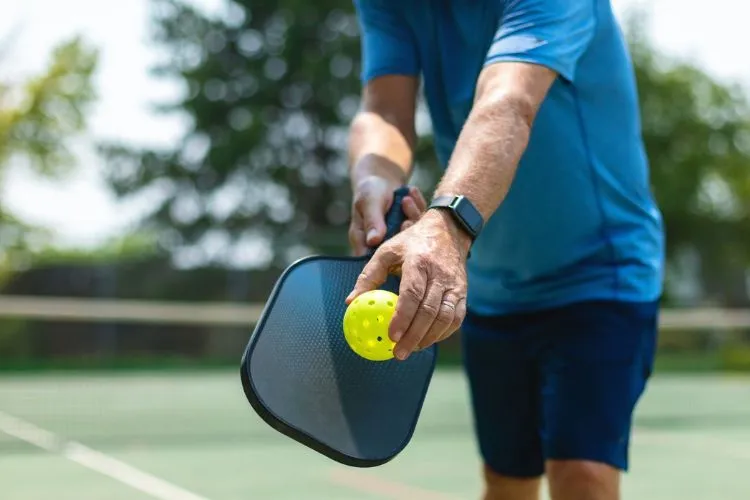Pickleball is an exciting sport that’s gaining popularity at a fast pace. It offers a unique blend of strategy, skill, and athleticism.
One crucial element of the game is the equipment, particularly the pickleball paddle.
With different sizes available, newcomers to the sport often find themselves wondering; which size paddle is right for me?
This article seeks to help you out by comparing two common paddle core thickness choices. Here’s a guide to 13mm vs 16mm Pickleball Paddle.

Understanding Pickleball Paddles
Knowing a pickleball paddle’s anatomy is crucial before discussing the difference. Let’s look at the paddle’s components.
Core, face material, edge guard, and grip are the major parts that make up a pickleball paddle. The core acts as the heart of the paddle. It’s an essential component that contributes to the overall thickness of the paddle.
The thickness of the paddle plays a significant role in how the game is played. It can impact power and control players experience during the game. The size of your paddle can often make or break your performance.
A paddle too thick might offer more power but less control, while a slim one may lack the punch while providing excellent control. Your playing style and skill level matter too when picking your preferred thickness.
13mm vs 16mm pickleball paddle Comparing 13mm and 16mm Paddles
Now let’s dissect the two types of pickleball paddles – the 13mm and the 16mm variant.
13mm Pickleball Paddles
A 13mm pickleball paddle is comparatively thinner. This lean design significantly contributes towards lighter weight and easy maneuverability. It’s particularly great for serving and dinking because of the increased control offered.

However, these paddles might lack the power for strong slams or drives as they have less mass working in their favor.
These paddles are perfect for beginners and intermediates players. They allow players to gradually build their skills without feeling overwhelmed by a heavy paddle.
16mm Pickleball Paddles
On the flip side, a 16mm pickleball paddle is designed for players who crave power. Being slightly thicker core provides extra heft that comes in handy for sends the ball far with minimal effort.

This edge in power, however, may come at the cost of control and maneuverability.Those who have mastered control and precision might find 16mm paddles appealing.
It provides players with the ability to make powerful shots, making these paddles suited for advanced players or aggressive play styles.
Side-by-Side Comparison
When comparing the 13mm and 16mm pickleball paddles, there are several aspects to keep in mind. These differences boil down to weight, power, control, handle size, and the sweet spot of the paddle.
Weight: 13mm paddles are generally lighter overall due to their thinner core. This lighter build makes them easier to handle, especially for beginners who are still acclimating to the equipment.
16mm paddles, being thicker, have a slightly increased weight that provides more power during shots but can be more challenging to manage for long durations.
Power: A 16mm paddle’s thicker core allows for more powerful shots, giving an edge to players who prefer aggressive gameplay.
The extra mass helps to send the ball further and harder with minimal effort on the player’s part. In contrast, the thinner 13mm paddles lend themselves more to controlled and deliberate shots.
Control: Thinner 13mm paddles offer greater control over shot placement and maneuverability. The lighter weight of these paddles makes it easier for players to respond quickly and maintain control over their swings.
In contrast, the 16mm paddle might give less control to the player due to its slightly increased heft, making precise shots more challenging.
Handle Size: Typically, the handle size remains consistent across both 13mm and 16mm paddles. However, there may be slight variations that cater to players’ preferences.
Beginners usually enjoy the grip offered by a 13mm paddle, while experienced players who have a better understanding of their needs may prefer the extra support a 16mm paddle can provide.
Sweet Spot: The sweet spot of a paddle is the most responsive area that gives players the best control and power. The location and size of the sweet spot may vary according to the thickness of the paddle.
With thinner 13mm paddles, the sweet spot is generally larger and more forgiving, allowing for more consistent shots. In contrast, the thicker 16mm paddles usually have a smaller sweet spot that rewards precise and accurate play with more power.
As you decide between 13mm and 16mm pickleball paddles, considering your skill level, experience, and unique play style is key.
Whether you’re a beginner looking for a comfortable grip or a seasoned player seeking a powerful shot, the right thickness can improve your overall performance and make the game even more enjoyable.
13mm or 16mm pickleball paddle: What is better for beginners?
For beginners entering the game of pickleball, understanding paddle sizes can be a daunting task. The choice between 13mm and 16mm pickleball paddles might seem confusing, but each has its own advantages catering to different player needs.
A 13mm paddle, being thinner, is usually lighter and could offer beginners an edge due to its easier manageability.
The lighter design of a 13mm paddle is especially beneficial for dinking and serving, as it provides the player with increased control. This is an important aspect for beginners, who are learning the ropes and developing their play style.
However, while the 13mm paddle is easier to control, it might lack the power necessary for stronger slams or drives, as it doesn’t have as much mass.
This feature becomes crucial as players progress into intermediate levels and start to play more aggressively.On the other hand, the 16mm paddle is thicker and heavier, providing extra power for potent shots.
However, this extra weight might come at a cost of maneuverability and precision, making these paddles a little more challenging for beginners who are just starting to learn control and precision.
In essence, beginners might find a 13mm paddle easier to control, while experienced players could appreciate the power advantages of a 16mm paddle.
Therefore, beginners are often recommended to start with a 13mm paddle and as their skills progress, consider moving to a 16mm paddle.
Always remember that choosing a paddle is a personal preference and it’s important to use a paddle that feels comfortable and convenient to play with.
If possible, beginners should ideally try out both sizes to decide which fits their style and comfort the best.
You may also find interesting: Graphite vs Composite Pickleball Paddles | Onix Z3 vs Z5
Making the Right Choice: Tips for Players
Choosing between a 13mm and a 16mm pickleball paddle depends on a few key factors. Your skill level comes first. Are you a beginner, intermediate, or advanced player?

Beginners usually get along well with 13mm paddles. As your skills improve, you may feel the need for more power and hence move to a 16mm paddle.
Always remember to choose a paddle with a comfortable weight. A heavy paddle can lead to arm fatigue and affect your gameplay.
Do not be afraid to experiment with different paddles. It’s often the best method to find out your preference.
Frequently Asked Questions (FAQs)
u003cstrongu003eWhat is the role of paddle core thickness in the game of pickleball?u003c/strongu003e
The core thickness in a pickleball paddle affects the weight, balance, control, and power of the paddle. Thicker paddles often provide more power but less control, while thinner ones offer less power but greater control.
u003cstrongu003eHow does the thickness of a pickleball paddle impact its performance?u003c/strongu003e
The thickness of your paddle directly influences its performance. A thicker paddle tends to be heavier and allows stronger hits but might lose maneuverability and control. In contrast, a thinner paddle offers better control and is easier to handle due to its light weight but might compromise on power.
Conclusion:
Picking the right pickleball paddle is crucial. Players need to consider the effects of paddle thickness on their performance. Both 13mm and 16mm paddles have unique advantages that cater to different skill levels and play styles.
Remember, there’s no one-size-fits-all pickleball paddle. Keep experimenting until you find what suits you best and enhances your enjoyment of the game.
It’s not unusual to be confused about whether to go for a thicker or thinner pickleball paddle. Let’s answer some of the most frequently asked questions about this matter to provide clarity.
Keep in mind that while your paddle and its size influence your game, they don’t define it. Regular practice and well-perfected strategy are equally important.
Consult professional or experienced players for their recommendations and findings about paddle sizes. Last but not least, your comfort should always be a priority while choosing a paddle.
A comfortable paddle makes the game all the more enjoyable. Happy pickleball playing!

Pickleball’s more than a game to me—it’s a passion. I write, sharing its highs and lows, the thrills and the lessons. Some tales might draw you to the court, while others give a hint of the game’s magic. So, curious about my journey? Ready to dive deep into the world of pickleball with me? Let’s go.
